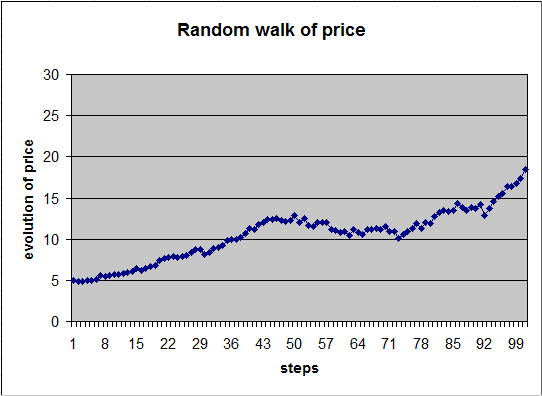
Some considerations on calculus and stochastic calculus
Calculus was invented in the XVIIth century to extend the calculation of areas to more complicated figures than rectangles, in particular to areas under curves.
See a digression on calculus for a presentation of this mathematical technique.
Stochastic calculus is an extension of calculus and of simple probability calculations to be able to compute the probabilistic behavior of random walks.
Below is an example of a geometric random walk with 100 steps. It is the price of a security beginning at 5 euros, and which, at each step, it is multiplied by a quantity 1 + Rn where Rn is a random variable normally distributed with mean 1% and standard deviation 3%.

Consider the following questions:
1) What is the probability that, at step 100, the price be greater than or equal to 20 euros?
2) What is the probability that, at step 100, the price be between 26€ and 27€?
3) If, at time 0 (the beginning of the random walk), I enter into a contract with an investor, whereby I promise the investor to pay him whatever difference there is between the end price of the random walk and 20 euros if the end point is above 20 euros, and zero otherwise, and the risk-free rate is r0 (for instance 0,05% at each step), how much on average shall I have to pay him? And therefore how much can I ask him to pay me to enter into the contract?
All these questions can be answered with stochastic calculus.
The third question is the calculation of the price of a call option with exercise price 20 euros, given that the "underlying asset", one hundred steps before the exercise date, is at 5 euros, the risk free rate is r0, and the random walk has the above described characteristics.
Call options and other types of options play an important role in modern finance. For example, when the investor buys from me the above call option, he becomes sure to be able, at "exercise price", to buy the underlying asset at 20 euros at the most (because, if the price is higher, I'll pay him the difference). Thus the investor buys from me a protection. It belongs to the general field of hedging (hedge = barrier, protection).
We shall study the solutions to these questions in lesson 9 on derivatives.